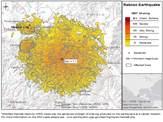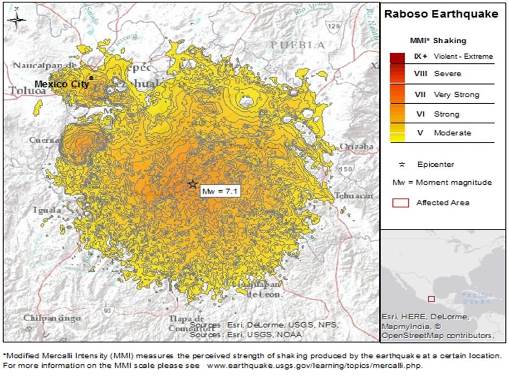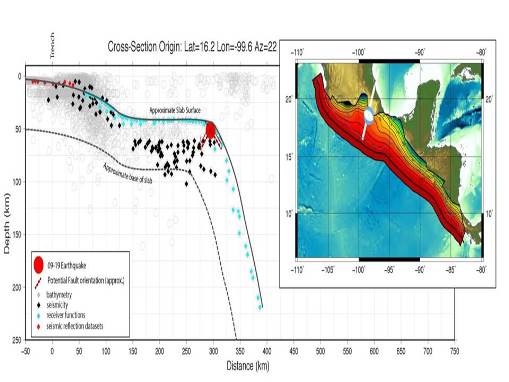

A magnitude (Mw) 7.1 earthquake struck near Raboso, Mexico in September of 2017, according to the U.S. Geological Survey (USGS). The quake occurred at 1:14 p.m. local time (18:14 UTC), with Mexico City approximately 122 kilometers (75.9 miles) southeast of the epicenter.
According to government officials, at least 226 fatalities and 1,000 injuries have been reported. Major damage has been reported across states in the center of the country, including dozens of building collapses and broken gas mains. Rescue missions are underway to find survivors in collapsed buildings. It will take some time to fully assess both the scope and severity of impacts of this event, and our first thoughts and concerns are with those directly affected by this event.


Slab cross-section, moment tensor solution and hypocenter location of the M7.1 earthquake; Source: Gavin Hayes, USGS NEIC
Hazard data illustrated in the CAT-i map was taken from GC AdvantagePoint®, Guy Carpenter’s web-based risk management platform. GC AdvantagePoint users can view impacted areas on any map as well as see how their portfolios were affected. Please contact your broker or cat modeling analyst for further information.
Geological Background
The Mw 7.1 earthquake occurred as the result of normal faulting at a depth of around 50 kilometers, according to the USGS. Indications point towards a strike on moderately dipping faults either to the southeast or the northwest. The characteristics of this event suggest that it is a probable intraplate event within the subducting Cocos slab. The Cocos plate begins its subduction beneath Central America at the Middle America Trench, about 300 kilometers to the southwest of this earthquake, according to the USGS. The panel above shows a cross-section of the area in question.
The shaking intensity was most intense for structures with a building period of about 0.3 seconds, corresponding to typical mid-rise buildings.
Impacts
It will take some time to fully establish the scope and severity of the impacts of this event. According to government officials, at least 226 fatalities have been reported in Mexico, with 117 fatalities reported in Mexico City, 55 in Morelos State, and 39 at the center of the quake in Puebla State, according to media reports.
A number of buildings suffered severe damage in and around Puebla State, according to media reports. The mayor of Mexico City stated that buildings fell at 44 sites in the capital alone. Shake Intensity reports have indicated the earthquake will predominately impact three- to five-story structures, as reported by the USGS.
More than 20 children and two adults were found dead at a school in the neighborhood of Coapa, according to Mexican President Enrique Peña Nieto, as reported by the media.
Reports also indicate that at least 209 schools were affected by the quake, 15 of which have suffered severe damage. Schools were ordered closed on Wednesday and public transportation is allowing free service to allow people to access their homes, according to media reports.
Fifteen fatalities were reported when a church near Mexico's Popocatepetl volcano collapsed during Mass. The volcano itself had a small eruption as a result of the earthquake.
Mexico City airport suspended operations pending a full status check of the facility. Power outages affected homes and businesses across the impact zone, with an estimated 4.6 million locations affected.
Initial estimates put the most probable economic loss between USD 1 billion and USD 10 billion, according to the USGS Pager Service. According to the USGS, extensive damage is probable and the disaster is probably widespread with a possible national or international level response.
According to the USGS, the same region has experienced 19 events over the last century with a magnitude of 6.5 or greater (within 250 kilometers of the hypocenter of this event).
Sources: USGS, Associated Press, Reuters, BBC News, Los Angeles Times
Guy Carpenter publishes CAT-i reports for major natural catastrophes worldwide. These reports cover catastrophes including worldwide tropical cyclones, earthquakes, major UK and European floods and any other natural event that is likely to incur a significant loss to the (re)insurance industry. Please email CAT.i@guycarp.com if you wish to be added to the free email distribution list.